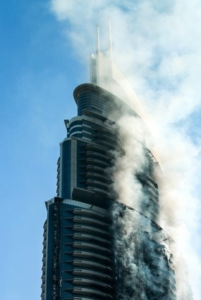UAE fire-safety recommendations to be drawn up for buildings
DUBAI // Fire-safety authorities are working on guidelines to reduce the risk of fire spreading quickly on buildings with flammable cladding.

Tests will be run by experts to see if fire barriers will keep residents safe in older buildings with combustible aluminium facades.
“Each building will have different solutions depending on the percentage of cladding, the severity of the possible problem and design and construction,” said Lt Col Jamal Ibrahim, director of preventive safety at Dubai Civil Defence.
“I need people to be safe and we need the systems suggested to be approved. This is a new approach for us. There is no set standard test but we must find solutions.
“So we are finalising two to three tests with manufacturers, experts and federal officers. We are working with the municipality, a federal committee and other emirates on solutions.”
Lt Col Ibrahim said that after a fire, if the facade were deemed to have helped the blaze to spread, all of it should be replaced. Aluminium cladding with a combustible thermoplastic core has been a problem in recent tower fires.
“We are still in talks with some owners to tell them that if you have a fire on one side, like with The Torch or Tamweel, they must change all the cladding, even if it was not reached by the fire,” Lt Col Ibrahim said.
Due to the high cost of replacing cladding, other approaches are being worked on for most buildings, such as adding fire breaks or fire-retardant exteriors.
Authorities aim to provide solutions for building owners and associations after the comprehensive studies in Dubai and Abu Dhabi have been completed.
“Let’s say we know the cladding is combustible, so what can we do to mitigate it? This approach needs testing,” said Pramod Challa, chief of engineering with Dubai Civil Defence. “We need fire tests because without this we cannot tell owners to take this or that measure with confidence.”
Experts have backed plans for breaks or fire-retardant facades.
“The idea is that you slow the fire down and hopefully stop it with fire breaks,” said Andy Dean, regional head of facades at WSP Parsons Brinckerhoff, a global engineering and design firm.
“If you know a panel on an existing building is combustible, there is discussion about removing sections of the panel and replacing it with a non-combustible or less combustible material.
“So if the facade starts to burn and reaches these non-combustible panels, it’s more difficult for the fire to get to the next section. It is preferential in commercial terms to only take out parts of the facade rather than replace the whole facade.”
Michel Francis, chief architect at DEC, a building design and project management company, said safety treatment could help.
“It’s very rare a fire starts on the facade so you need to prevent the fire from extending to it,” he said.
“There should be treatment done from the inside and on the top and bottom of windows from the outside to make sure a fire does not reach in through the windows on the remaining floors.
“So in many cases you may not need to take off all the facade.”





